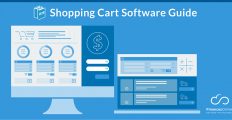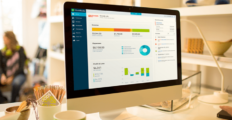Every modern-day store, big and small, won’t be complete without a POS software. More than anything, this compilation of POS statistics shows how this powerful piece of technology has made the lives of grocers, retail store owners, and other entrepreneurs easier and more productive. In fact, POS software is now regarded as the heart of any business, evolving from the lowly cash register into a comprehensive suite of business solutions.
And because it pays to be updated about the latest business information, we’ve gathered the latest POS statistics you must learn today. This way, you can readily make informed decisions to your company’s advantage.

POS Statistics You Must Learn Table of Contents
1. General POS Statistics
From simply processing customer orders, POS systems have advanced so fast that they’ve become multi-functional hubs for businesses across industries. Today’s fast-evolving POS platforms now offer a wide range of features and functionalities, such as menu creation, tableside ordering, employee management, CRM, inventory management, etc. This is why the POS market is among the most dynamic in the world today, as evidenced by these key statistics:
- In 2020, the market size value of POS software reached $9.3 billion. It is forecasted to hit $18.1 billion by 2027. (Grand View Research, 2020)
- The top POS priorities among North American retailers for 2020 are omnichannel capabilities integration (59%), improve existing POS (52%), unified ecommerce platform (44%), mobile POS (44%), POS upgrade or replacement (41%), and hardware upgrade (30%). (Retail Consulting Partners, 2020)
- The largest POS market segment is POS hardware, which is predicted to reach $66.30 billion by 2025. (Grand View Research, 2020)
- 59% of retailers made focusing on omnichannel capabilities their top POS priority in 2020. Meanwhile, 52% of retailers wanted to enhance their POS systems in the same year. (Retail Consulting Partner, 2020)
- Compliance (7%) and considering a unified payment platform (7%) are the least of retailers’ priorities in 2020. (Retail Consulting Partner, 2020)
Source: Retail Consulting Partners 2020 POS/Customer Engagement Survey
2. Mobile POS Payment Statistics
Mobile payment systems have been enjoying high consumer adoption and conversion rates, mainly due to their usability. Aside from providing considerable convenience, mobile POS systems offer unparalleled access to a vast array of consumer information that can be transformed into actionable insights using AI and analytics.
- For 2020, the total mobile POS transaction value was $1,017,982 million and is projected to reach $2,489,471 million in 2021. (Statista, 2020)
- 16.9% – the expected annual growth of mobile POS value from 2021 to 2025. (Statista, 2020)
- By 2025, the value of mobile POS market value is expected to reach $4,650,556 million. (Statista, 2020)
- There are 1,490.5 million users of mobile POS payments worldwide as of 2021. (Statista)
- 54% of businesses have used mobile POS for processing transactions. (Retail Consulting Partner, 2020)
- 79% of stores that use POS systems are small and mid-sized brands, while 21% are large enterprises. (Connect POS, 2021)
- 23% of mobile POS users still can’t accept payment using the tool. (Retail Consulting Partner, 2020)
- Today, 46% of retailers don’t utilize mobile POS to process their transactions. (Retail Consulting Partner, 2020)
- As of 2020, 50.6% of mobile POS users are male and 49.4% are female. (Statista)
- Among consumers, 28.6% of mobile POS users are between 25 and 34 years old, which is also the age group with the largest number of users. (Statista)
- The year-on-year growth rate of mobile POS payment users is +10.1%. (Statista)
- In 2019, the average transaction value of mobile POS payments per user is expected to reach $7,960.5 in 2021. (Statista)
- Total number of mobile POS payment users is expected to reach 85.6m by 2025. (Statista)
- Experts predict that the transaction value of mobile POS payments will reach $1,006,220 million by 2025. (Statista)
Mobile POS Payment Users Based on Income
- 30.8% belong to the low-income bracket. (Statista)
- 30.5% are medium-income earners. (Statista)
- 38.6% are high-income earners. (Statista)
Mobile POS Payment Users based on Age Groups
- 21.1% = 18–24 years (Statista)
- 26.8% = 25–34 years (Statista)
- 26.2% = 35–44 years (Statista)
- 16.3% = 45–54 years (Statista)
- 7.8% = 55–64 years (Statista)
Mobile POS Payment Transaction Value (2017–2025)
- $4,165.8 in 2017 (Statista)
- $5,114.45 in 2018 (Statista)
- $6,063.1 in 2019 (Statista)
- $7,011.80 in 2020 (Statista)
- $$7,960.5 in 2021 (Statista)
- $8,909.14 in 2022 (Statista)
- $9,857.8 in 2023 (Statista)
- $10,806.5 in 2024 (Statista)
- $11,755.2 in 2025 (Statista)

3. POS User Personalization Statistics
Nowadays, the best way to provide what most people want is through personalization. And to complete the seamless customer experience, which is known to result in customers purchasing 47% more than they originally planned. This means that service should be omnichannel, secure, and provided in real-time. This is why top global brands must assume a holistic strategy to shape the customer journey and to better adapt to essential POS trends.
- 34% of retailers use mobile website or applications to retrieve customer information they can use to create a more personalized experience. (Retail Consulting Partner, 2020)
- 78% retailers plan to use mobile apps to help with identifying the customers in their stores. (Retail Consulting Partner, 2020)
- 56% of retailers can retrieve buyers’ contact information during checkout; 22% of retailers can do so before checkout and 7% can get a buyer’s contact details after checkout. (Retail Consulting Partner, 2020)
- 35% of retailers are already offering personalized rewards based on customer loyalty. Meanwhile, 23% of retailers plan to offer personalized rewards within 12 months, and another 23% plans to do the same within 1-3 years. (Retail Consulting Partner, 2020)
- 41% of retailers plan to add “suggested selling based on previous purchases” within 1-3 years as part of creating a more personalized experience for the buyer. This is already being offered by 22% of retailers and another 22% also plan to implement the same personalization approach within 12 months. (Retail Consulting Partner, 2020)
- 23% of retailers are exploring NFC & Beacons and 15% uses media listening as alternative customer identification technologies. (Retail Consulting Partner, 2020)
- 91% of shoppers are more likely to buy in stores that can provide more personalized and relevant suggestions. (Accenture)
- 83% of consumers are willing to divulge personal information in exchange for a personalized shopping experience. (Accenture)
- More than 86% of the total software spending in the retail industry is dedicated to the concept of “unified commerce.” (Yahoo News, 2020)
- For 79% of shoppers, a key consideration when looking for stores to shop is personalized service. (Retail Consulting Partner, 2020)
- 56% of consumers opt for businesses with brands that allow shoppers to use a shared cart across different channels. (Retail Consulting Partner, 2020)
Source: Retail Consulting Partners 2020 POS/Customer Engagement Survey
4. Cloud-Based POS Statistics
In the past, the best on-premise POS systems dominated the market, heralding a major evolution in how business transactions are done. Then came cloud-based POS solutions, which offered far more advantages compared to legacy systems. However, on-premise POS platforms still have some specific uses and contexts that some retailers prefer, although the trend indicates a continuing shift to cloud-based solutions.
- Only 7% of retailers are currently using cloud-based POS, but 28% claim that they plan to adopt cloud-based POS in the future. (Retail Consulting Partner, 2020)
- 52% of corporate organizations have fully transitioned to cloud-based POS; 40% more are planning to migrate to cloud-based POS. Only 7% of retailers are currently using cloud-based POS, but 28% claim that they plan to adopt cloud-based POS in the future. (Retail Consulting Partner, 2020)
- Cloud POS systems have gone beyond the 20% critical level in market penetration. This covers all retail categories except for cafeteria businesses. (Reforming Retail)
- More than 60% of recent POS system purchases were cloud platforms, setting a new milestone when cloud platforms first surpassed legacy systems. (LINGA)
- Before 2022 begins, a 50% cloud POS adoption rate is expected to be reached in all restaurant categories. (LINGA)

Most Popular Point-of-Sale Software
- Toast POS. A tablet-based restaurant management solution offering POS tools, customer management features, and team management options to streamline operations. Learn more about this product in this in-depth Toast POS review.
- Vend. A POS system and retail management software that supports customer management, order processing, payment processing, as well as inventory management. Check out this Vend review to see its complete feature set.
- Square A powerful POS system that can prepare invoices, track inventory, manage customer profiles, and record sales data. For more details, check out our Square review.
- TouchBistro. An iPad-based POS system built for the foodservice industry that provides table management, order management, inventory tracking, and staff management. View our TouchBistro review for more information.
- Oracle Food and Beverage. A point-of-sale platform for different establishments offering inventory management, front-of-house management, as well as real-time reporting and analytics. To learn more, see our Oracle Food and Beverage review.
5. AI-Powered POS Statistics
If there’s one cutting-edge technology that’s influencing POS systems the most, it’s artificial intelligence (AI). An AI-powered POS solution can readily go beyond its common functions to provide advanced features, including speech recognition and machine learning. Here are a few significant POS + AI statistics:
- 15% of businesses in the United States have used POS with AI capabilities. (ConnectPOS, 2021)
- 40% of US-based businesses are planning to use AI-enabled POS within the next 12 months. (ConnectPOS, 2021)
- 40% of customers in the 18-24 age group are happy with the AI-integration in stores that meet their expectations and preferences. (ConnectPOS, 2021)
- Experts predict that AI-enabled services will grow further, with 15% of businesses already deploying it in their POS systems. (Adobe Blog)

Among all technology providers using AI, POS vendors are some of the top users. Because of this, more and more businesses can benefit from AI-powered features in their POS systems. These include the capability to use POS data to track and learn from customer behavior as well as for deploying smart inventory replenishment and automated order fulfillment.
6. POS Report & Analytics Statistics
Enhanced reporting and analytics capabilities are some of the most significant advancements in the current crop of POS systems. Access to this robust functionality empowers POS system users to leverage their deeper knowledge of customer behavior and purchasing habits to their advantage. Here are some relevant statistics on this:
- 78% of retailers are not capable of identifying their customers until checkout. (Retail Consulting Partner, 2020)
- 22% of retailers do not have the capability at all to identify their customers. (Retail Consulting Partner, 2020)
- 22% of retailers use their customers’ purchase history to suggest new products or services. (Retail Consulting Partner, 2020)
- A survey of small businesses shows that 50% of small businesses believe that the various reports that they generate are crucial in helping sustain their POS usage. (Salesforce)
- 75% of companies are planning to allocate in-store mobile tools in their budgets within the next year. (Salesforce)

Small business owners are now in an advantageous position to leverage the constantly increasing capabilities of POS systems. The rich consumer insights that POS solutions bring offer SMBs a streamlined approach to help them provide their customers with a personalized shopping experience.
7. POS Data & Security Statistics
POS technology has become a reliable tool to combat retail losses in recent years. While other loss prevention methods rely on various video monitoring techniques, POS uses its robust analytics capabilities to identify and prevent losses. Loss prevention providers already include POS data analytics in the services they provide.
- 49.3% of retailers agree that fraudulent activities occur the most during in-store-only purchases. (NRF, 2020)
- Multichannel purchases (bought online and picked up in-store) are also vulnerable to fraudulent activities according to 18.8% of retailers. (NRF, 2020)
- The use of POS exception-based CCTV interface as part of security measures has increased by more than 16% since 2019, rounding up the businesses utilizing this technology to 49.3%. (NRF, 2020)
- 72.5% of businesses use POS data mining as part of their loss prevention system. (NRF, 2020)
- In 2019, 65.1% of US-based retailers turned to POS data to power their loss prevention efforts, registering a 7.9% increase from the previous year. (NRF, 2019)
- Over 56% of retailers in the US have already deployed POS analytics to combat fraud. (NRF, 2020)
- New POS systems-based technologies, such as fingerprint ID, are emerging, with 5.8% of retailers already using the technology, 2.9% in the testing phase, and 2.9% planning to implement in 2021. (NRF, 2020)
- In 2013, retail giant Target became the victim of one of the biggest POS data breaches of all time, where its POS systems were infected by a trojan to steal the credit card information of over 70 million customers. (Digital Guardian)
- In 2014, Home Depot was attacked using a POS malware, affecting as much as 2,200 branches and 56 million customers. (Digital Guardian)
- Hackers stole the credit card data of Wendy’s customers in 2016. Involving over a thousand branches, the data breach led to multiple lawsuits against the fast-food giant. (Digital Guardian)
Source: National Retail Federation: National Retail Security Survey 2020
Let These Statistics Help You Find the Right POS Software
Today’s POS systems have truly become the heart of any business operation. They have come a long way from their initial functions to process and register customer orders to now help customers keep on coming to your stores. Thanks to AI and other innovations, these solutions have truly become an indispensable tool for the modern enterprise, allowing them to gather customer data.
But the story doesn’t stop there as POS vendors are likely to come up with new and exciting features in the near future. And as we wait for that next big thing in POS technology, it’s very worthwhile to consider these POS statistics, especially if you are planning for an upgrade or a new system for your business.
And in case you’re already in the market for a POS system, it’s best to read more about the best POS systems for sales for 2024. The more informed you are, the better will you be able to make the right choice. Besides, being the core of your operations, your choice of a POS system will be a make-or-break decision.
References:
- Accenture. (2018). 2018 Personalization Pulse Check. Retrieved from Accenture
- Adobe. (2018). Study Finds Investments In Customer Experience Are Paying Off. Retrieved from Adobe
- ConnectPOS. (2021). Retail POS Trends and Statistics for 2021. Retrieved from ConnectPOS
- Digital Guardian. (2020). What is POS Security? Protecting Data in POS Environments. Retrieved from Digital Guardian
- LINGA. (n.d.). Market Trends Point to Cloud POS as the Future. Retrieved from LINGA
- National Retail Federation. (2020). 2020 National Retail Security Survey. National Retail Federation
- R.C.P. (2020). 2020 POS / Customer Engagement Survey Report. Retrieved from R.C.P
- Reforming Retail. (n.d.). Have We Reached Peak Legacy POS? Retrieved from Reforming Retail
- Salesforce. (2021). 4 Ways To Take Your Digital Experience From Good To Great. Retrieved from Salesforce
- Statista. (2021). Mobile POS Payments. Retrieved from Statista
- Statista. (2021). Mobile POS Payments. Retrieved from Statista
- Yahoo. (2020). Unified Commerce Markets Analysis 2020: Over 86% of All Software Spending in Retail Is Now Focused on the Concept of Unified Commerce. Retrieved from Yahoo






















Leave a comment!